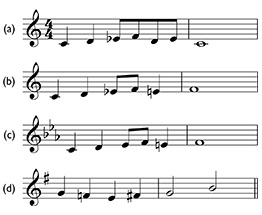6.2 Accidentals in practice
Let’s look at some examples to see how accidentals work in practice. In Example 57 (a), the key signature is for C major (no sharps or flats), but we want to have E♭ s. We therefore add a flat before the first E to lower it a semitone to E♭. Accidentals, unless cancelled, last throughout a bar, and so the second E will also be an E♭.
If we want to write an E♮ rather than an E♭ later during the bar as in Example 57 (b), we have to cancel the earlier flat by writing a natural before the second E.
Example 57

Example 57 (c) will produce exactly the same melody as Example 57 (b), but uses the C minor key signature. The first E will be E♭ because of the E♭ in the key signature (and does not therefore need a flat), but the second E will need a natural to raise it a semitone from E♭ to E♮.
Finally, in Example 57 (d), the first F needs a natural to cancel the effect of the F♯ in the key signature, but the second F then needs a sharp to cancel the effect of the natural before the first F.
Three final points (which mostly reinforce what you’ve learned already):
Accidentals in practice: summary
- Notice that we use ‘sharpen’ to mean ‘raise by a semitone’. So, we can say: ‘We need to sharpen A♮ to become A♯’. But we can also say: ‘We need to sharpen A♭ to become A♮’. (We saw this principle in operation in the previous activity, in the D minor answer for Group 1 Activity 1 in the previous review.) Conversely, we use ‘flatten’ to mean ‘lower by a semitone’.
- When identifying notes without accidentals, it is tempting to say simply, ‘This is C’. However, always remember that this is a shorthand for saying, ‘This is C♮’.
- Key signatures consist of groups of accidentals that are either sharps or flats. There is never a mixture.
